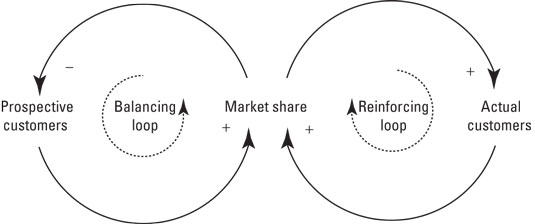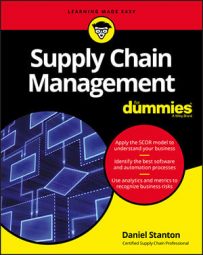Your car is a good example of a system that you depend on every day. You expect your car to move you from Point A to Point B. In fact, you probably take for granted that your car will take you to Point B any time you want to go. Your car is actually a system, though, and it can perform the way you expect it to only if all the components are operating correctly. A dead battery, a broken fuel pump, or worn-out brakes could bring the whole system to a halt (or, in the case of the worn-out brakes, not bring the system to a halt!).
Supply chains are systems, too. The components that make up supply chains are people, processes, and technologies. Each of these components needs to be organized and managed correctly for the system to operate as expected.
When you look at them as systems, you begin to see that supply chains have underlying rules and patterns that are key to understanding how they work. A good example of one of these patterns is when a company experiences wild swings in inventory levels. It can be hard for people in the company to understand why these swings occur until you look at the supply chain as a system. Then you can recognize a pattern called the Bullwhip Effect, in which inventory peaks and valleys are amplified as they move upstream from one step to the next in a supply chain. The Bullwhip Effect is a problem that frequently occurs in supply chain systems, and it is a normal, predictable result of everyone in the supply chain making decisions that seem logical. To fix the problem, you need to change the system, and that means you need to understand what is really happening. Here's a scenario that explains how a Bullwhip Effect can occur:
A customer comes in to buy a widget, which turns out to be the last widget in the store, so the store needs to order more inventory from its wholesaler. But the wholesaler doesn't sell individual widgets; it sells widgets in cases of 100 units. Now the store has to buy a full case — 100 widgets — even though it sold only one. If that was the last case in their warehouse, then the wholesaler will replenish its inventory by ordering more widgets from the factory. The factory, however, sells widgets in batches of 100 cases, so the wholesaler has to buy 100 cases of 100 widgets each. The wholesaler just bought 10,000 widgets even though it only sold 100.
How many widgets did the factory sell? 10,000. How many did the wholesaler sell? 100. And how many did the customer buy? Yep. . . just 1. A small demand signal at the end of the supply chain became amplified at every step, creating a Bullwhip Effect on inventory. The store may never sell another widget, so it would still be stuck with 99 widgets in inventory. The wholesaler may never sell another case of widgets, so it may be stuck with 99 cases of widgets. All that extra inventory costs money for everyone in the supply chain without adding any value.
Here are three ways that you can change the system that can reduce and even eliminate the Bullwhip Effect:
- Make batches smaller. The fewer of widgets that the store and the wholesaler need to buy, the less amplification occurs when orders move up the supply chain.
- Improve forecasting. If all the partners in the supply chain have a better forecast, there's less chance of ordering widgets that no one will buy.
- Improve communications. If the store, the wholesaler, and the manufacturer know exactly how many widgets are being sold, they can do a better job of managing their inventories.
Supply chains are really systems, where the people, processes, and technologies interact in complex ways. Managing your supply chain as a system may require a different approach to measuring success than what functional teams normally use.
In some cases, it helps to build a model of your supply chain to show how the parts of the system interact. These models can show cause and effect relationships — how one thing affects another, which then causes something to happen, which causes something else to happen, and so forth. In other words, these models can show causal relationships. Very often, systems models reveal reinforcing loops, where a series of events repeats over and over, getting stronger each time. Or, they can show balancing loops that have the opposite effect in which a series of events gets weaker over time.The figure is an example of a causal loop diagram, one of the most common tools for modeling the dynamics of a system. In this example you can see how two important supply chain dynamics both affect the market share for a company. As the number of customers increases, the market share grows higher. But as the market share goes up, the number of prospective customers gets smaller. That's because the prospects have now become customers. As the number of prospects gets smaller, the increase in market share slows down and eventually stop growing.
 Example of a causal loop diagram.
Example of a causal loop diagram.A few universities now require their supply chain management students to take classes in system dynamics, which includes a whole set of tools for predicting how supply chains behave over time. System dynamics was originally developed in the 1950s by MIT professor Jay Forrester.
System dynamics modeling usually requires special software. You'll find reviews of several different options at Wikipedia, but if you are looking for a simple tool that gives you a chance to see some examples and try building your own system dynamics model for free, check out Insight Maker.

